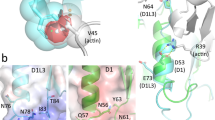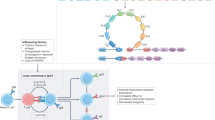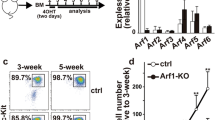Abstract
CD23, the low-affinity immunoglobulin E receptor, is an important modulator of the allergic response and of diseases such as rheumatoid arthritis. The proteolytic release of CD23 from cells is considered a key event in the allergic response. Here we used loss-of-function and gain-of-function experiments with cells lacking or overexpressing candidate CD23-releasing enzymes (ADAM8, ADAM9, ADAM10, ADAM12, ADAM15, ADAM17, ADAM19 and ADAM33), ADAM-knockout mice and a selective inhibitor to identify ADAM10 as the main CD23-releasing enzyme in vivo. Our findings provide a likely target for the treatment of allergic reactions and set the stage for further studies of the involvement of ADAM10 in CD23-dependent pathologies.
This is a preview of subscription content, access via your institution
Access options
Subscribe to this journal
Receive 12 print issues and online access
$209.00 per year
only $17.42 per issue
Buy this article
- Purchase on Springer Link
- Instant access to full article PDF
Prices may be subject to local taxes which are calculated during checkout




Similar content being viewed by others
References
Heyman, B. Regulation of antibody responses via antibodies, complement, and Fc receptors. Annu. Rev. Immunol. 18, 709–737 (2000).
Pene, J. et al. Interleukin 5 enhances interleukin 4-induced IgE production by normal human B cells. The role of soluble CD23 antigen. Eur. J. Immunol. 18, 929–935 (1988).
Yu, P., Kosco-Vilbois, M., Richards, M., Kohler, G. & Lamers, M.C. Negative feedback regulation of IgE synthesis by murine CD23. Nature 369, 753–756 (1994).
Payet, M.E., Woodward, E.C. & Conrad, D.H. Humoral response suppression observed with CD23 transgenics. J. Immunol. 163, 217–223 (1999).
Lecoanet-Henchoz, S. et al. CD23 regulates monocyte activation through a novel interaction with the adhesion molecules CD11b-CD18 and CD11c-CD18. Immunity 3, 119–125 (1995).
Lecoanet-Henchoz, S. et al. Mouse CD23 regulates monocyte activation through an interaction with the adhesion molecule CD11b/CD18. Eur. J. Immunol. 27, 2290–2294 (1997).
Plater-Zyberk, C. & Bonnefoy, J.Y. Marked amelioration of established collagen-induced arthritis by treatment with antibodies to CD23 in vivo. Nat. Med. 1, 781–785 (1995).
Kleinau, S., Martinsson, P., Gustavsson, S. & Heyman, B. Importance of CD23 for collagen-induced arthritis: delayed onset and reduced severity in CD23-deficient mice. J. Immunol. 162, 4266–4270 (1999).
Huissoon, A.P., Emery, P., Bacon, P.A., Gordon, J. & Salmon, M. Increased expression of CD23 in rheumatoid synovitis. Scand. J. Rheumatol. 29, 154–159 (2000).
Ribbens, C. et al. Increased synovial fluid levels of soluble CD23 are associated with an erosive status in rheumatoid arthritis (RA). Clin. Exp. Immunol. 120, 194–199 (2000).
Molica, S. et al. Cellular expression and serum circulating levels of CD23 in B cell chronic lymphocytic leukemia. Implications for prognosis. Haematologica 81, 428–433 (1996).
Sarfati, M. et al. Prognostic importance of serum soluble CD23 level in chronic lymphocytic leukemia. Blood 88, 4259–4264 (1996).
Marolewski, A.E. et al. CD23 (FcεRII) release from cell membranes is mediated by a membrane-bound metalloprotease. Biochem. J. 333, 573–579 (1998).
Seals, D.F. & Courtneidge, S.A. The ADAMs family of metalloproteases: multidomain proteins with multiple functions. Genes Dev. 17, 7–30 (2003).
Blobel, C.P. ADAMs: key players in EGFR-signaling, development and disease. Nat. Rev. Mol. Cell Biol. 6, 32–43 (2005).
Parkin, E.T. et al. Structure-activity relationship of hydroxamate-based inhibitors on the secretases that cleave the amyloid precursor protein, angiotensin converting enzyme, CD23, and pro-tumor necrosis factor-α. Biochemistry 41, 4972–4981 (2002).
Fourie, A.M., Coles, F., Moreno, V. & Karlsson, L. Catalytic activity of ADAM8, ADAM15, and MDC-L (ADAM28) on synthetic peptide substrates and in ectodomain cleavage of CD23. J. Biol. Chem. 278, 30469–30477 (2003).
Kelly, K. et al. Metalloprotese-disintegrin ADAM8: Expression analysis and targeted deletion in mice. Dev. Dyn. 232, 221–231 (2005).
Kilmon, M.A., Shelburne, A.E., Chan-Li, Y., Holmes, K.L. & Conrad, D.H. CD23 trimers are preassociated on the cell surface even in the absence of its ligand, IgE. J. Immunol. 172, 1065–1073 (2004).
Gu, B., Bendall, L.J. & Wiley, J.S. Adenosine triphosphate-induced shedding of CD23 and L-selectin (CD62L) from lymphocytes is mediated by the same receptor but different metalloproteases. Blood 92, 946–951 (1998).
Sahin, U. et al. Distinct roles for ADAM10 and ADAM17 in ectodomain shedding of six EGFR-ligands. J. Cell Biol. 164, 769–779 (2004).
Peschon, J.J. et al. An essential role for ectodomain shedding in mammalian development. Science 282, 1281–1284 (1998).
Zhou, H.M. et al. Essential role for ADAM19 in cardiovascular morphogenesis. Mol. Cell. Biol. 24, 96–104 (2004).
Nagano, O. et al. Cell-matrix interaction via CD44 is independently regulated by different metalloproteinases activated in response to extracellular Ca2+ influx and PKC activation. J. Cell Biol. 165, 893–902 (2004).
Ludwig, A. et al. Metalloproteinase inhibitors for the disintegrin-like metalloproteinases ADAM10 and ADAM17 that differentially block constitutive and phorbol ester-inducible shedding of cell surface molecules. Comb. Chem. High Throughput Screen. 8, 161–171 (2005).
Rosenwasser, L.J. & Meng, J. Anti-CD23. Clin. Rev. Allergy Immunol. 29, 61–72 (2005).
Hundhausen, C. et al. The disintegrin-like metalloproteinase ADAM10 is involved in constitutive cleavage of CX3CL1 (fractalkine) and regulates CX3CL1-mediated cell-cell adhesion. Blood 102, 1186–1195 (2003).
Peduto, L., Reuter, V.E., Shaffer, D.R., Scher, H.I. & Blobel, C.P. Critical function for ADAM9 in mouse prostate cancer. Cancer Res. 65, 9312–9319 (2005).
Keegan, A.D., Snapper, C.M., Van Dusen, R., Paul, W.E. & Conrad, D.H. Superinduction of the murine B cell Fc epsilon RII by T helper cell clones. Role of IL-4. J. Immunol. 142, 3868–3874 (1989).
Umland, S.P. et al. Human ADAM33 messenger RNA expression profile and post-transcriptional regulation. Am. J. Respir. Cell Mol. Biol. 29, 571–582 (2003).
Hartmann, D. et al. The disintegrin/metalloprotease ADAM 10 is essential for Notch signalling but not for α-secretase activity in fibroblasts. Hum. Mol. Genet. 11, 2615–2624 (2002).
Christie, G. et al. IgE secretion is attenuated by an inhibitor of proteolytic processing of CD23 (Fc epsilonRII). Eur. J. Immunol. 27, 3228–3235 (1997).
Mayer, R.J. et al. Inhibition of CD23 processing correlates with inhibition of IL-4-stimulated IgE production in human PBL and hu-PBL-reconstituted SCID mice. Clin. Exp. Allergy 30, 719–727 (2000).
Roghani, M. et al. Metalloprotease-disintegrin MDC9: intracellular maturation and catalytic activity. J. Biol. Chem. 274, 3531–3540 (1999).
Rooke, J., Pan, D., Xu, T. & Rubin, G.M. KUZ, a conserved metalloprotease-disintegrin protein with two roles in Drosophila neurogenesis. Science 273, 1227–1230 (1996).
Wen, C., Metzstein, M.M. & Greenwald, I. SUP-17, a Caenorhabditis elegans ADAM protein related to Drosophila KUZBANIAN, and its role in LIN-12/NOTCH signaling. Development 124, 4759–4767 (1997).
Lammich, S. et al. Constitutive and regulated α-secretase cleavage of Alzheimer's amyloid precursor protein by a disintegrin metalloprotease. Proc. Natl. Acad. Sci. USA 96, 3922–3927 (1999).
Reiss, K. et al. ADAM10 cleavage of N-cadherin and regulation of cell-cell adhesion and beta-catenin nuclear signalling. EMBO J. 24, 742–752 (2005).
Horiuchi, K., Zhou, H.M., Kelly, K., Manova, K. & Blobel, C.P. Evaluation of the contributions of ADAMs 9, 12, 15, 17, and 19 to heart development and ectodomain shedding of neuregulins β1 and β2. Dev. Biol. 283, 459–471 (2005).
Schwartz, W. et al. Application of chemically-stable Immunoglobulin-selective sorbents: harvest and purification of antibodies with resolution of aggregate. BioProcessing J. 3, 53–62 (2004).
Fanslow, W.C. et al. Structural characteristics of CD40 ligand that determine biological function. Semin. Immunol. 6, 267–278 (1994).
Weskamp, G. et al. Mice lacking the metalloprotease-disintegrin MDC9 (ADAM9) have no evident major abnormalities during development or adult life. Mol. Cell. Biol. 22, 1537–1544 (2002).
Caven, T.H. et al. IL-21 dependent IgE production in human and mouse in vitro culture systems is cell density and cell division dependent and is augmented by IL-10. Cell. Immunol. 238, 123–134 (2005).
Conrad, D.H. & Peterson, L.H. The murine lymphocyte receptor for IgE. I. Isolation and characterization of the murine B cell Fcε receptor and comparison with Fcε receptors from rat and human. J. Immunol. 132, 796–803 (1984).
Kilmon, M.A. et al. Regulation of IgE production requires oligomerization of CD23. J. Immunol. 167, 3139–3145 (2001).
Unkeless, J.C. Characterization of a monoclonal antibody directed against mouse macrophage and lymphocyte Fc receptors. J. Exp. Med. 150, 580–596 (1979).
Acknowledgements
We thank V. Nikolenko and A. Shirazi for technical assistance; recombinant mouse IL-4 was a gift from W. Paul (US National Institutes of Health). Supported by the US National Institutes of Health (GM64750 to C.P.B and AI18697 to D.H.C.), the US National Institute of Allergy and Infectious Diseases (T32 AI07407 to J.W.F.) and the National Institutes of Health National Center for Research Resources Research Facilities Improvement Program (C06-RR12538-01 for construction of the facility housing the laboratory of C.P.B.).
Author information
Authors and Affiliations
Contributions
G.W., J.W.F., J.S, D.H.C and C.P.B. contributed to the experimental design, data analysis, critical discussions and manuscript preparation; G.W. did the experiments in Figures 1 and 2, the immunoblot in Figure 3c and the titration of the GI254023X inhibitor in Figure 4e for EGF in MEFs; J.W.F prepared and purified antibody 19G5 and did the experiments in Figures 3a,b and 4a–d; J.S. tested how GI254023X affects CD23 shedding from RPMI 8866 cells and primary human tonsillar B cells (Fig. 4e); S.M. and N.B. provided antibody 30X, which both had characterized before, and critical information for its use in Figures 1 and 2; ADAM-deficient mice were supplied by A.J.P.D. (Adam8−/−), A.S.-F. (Adam12−/−) and R.A.B. (Adam17−/−); Adam10−/−, Adam10+/−, wild-type control cells and mouse ADAM10 cDNA were from P.S. and D.H.; Adam33−/− cells and wild-type controls were from S.U.; S.S. injected wild-type and ADAM-deficient mice with antibody 19G5, isolated serum and collected spleens for the experiments in Figure 3a,b; A.L. and J.D.B provided GI254023X and BB94; J.D.B. provided information and discussions, especially at beginning; D.H.C and C.P.B supervised this study; and all authors contributed to the final stages of manuscript preparation.
Corresponding author
Ethics declarations
Competing interests
A.D., N.B., S.U., R.A.B. and J.D.B. are employed by pharmaceutical companies. Antibody 30X is the subject of patent WO 99/58679 (“Antibodies to CD23, derivatives thereof, and their therapeutic uses”).
Supplementary information
Supplementary Fig. 1
Generation of the humanized CD23 mAb 30X and specificity control. (PDF 934 kb)
Rights and permissions
About this article
Cite this article
Weskamp, G., Ford, J., Sturgill, J. et al. ADAM10 is a principal 'sheddase' of the low-affinity immunoglobulin E receptor CD23. Nat Immunol 7, 1293–1298 (2006). https://doi.org/10.1038/ni1399
Received:
Accepted:
Published:
Issue Date:
DOI: https://doi.org/10.1038/ni1399
This article is cited by
-
The metalloproteinase ADAM10 requires its activity to sustain surface expression
Cellular and Molecular Life Sciences (2021)
-
Autism-associated variants of neuroligin 4X impair synaptogenic activity by various molecular mechanisms
Molecular Autism (2020)
-
ADAM10 controls the differentiation of the coronary arterial endothelium
Angiogenesis (2019)
-
The emerging role of ADAM metalloproteinases in immunity
Nature Reviews Immunology (2018)
-
Transitional B cells commit to marginal zone B cell fate by Taok3-mediated surface expression of ADAM10
Nature Immunology (2017)



